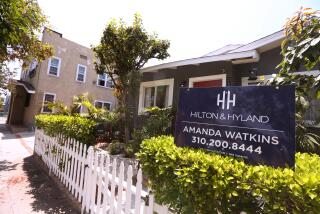Quality of Life Has Fallen, Poll Indicates : Survey: City residents blame overcrowding, foreigners, crime and traffic. They are losing faith in redevelopment as a provider of new jobs and money.
- Share via
GLENDALE — A new city study found Glendale residents feel that their quality of life has fallen in the past eight years due to overcrowding, foreigners, crime and traffic.
Though nearly four out of five said their quality of life is “good,” many also said it declined as the city grew from a bedroom community to a major financial center.
Some who have looked at the study, however, feel that economic conditions may have contributed to increased pessimism about the quality of life.
Faced with a tightening economy, Glendale residents are also losing faith that redevelopment can provide new jobs and money. Only 45% “strongly agreed” that redevelopment provided jobs. In a similar study in 1983, 64% strongly agreed.
The random telephone survey of 500 adults was conducted for the city by a Woodland Hills research firm in September.
The percentage of residents who described the quality of life in Glendale as “excellent” or “very good” fell from 70% in 1983 to 35% in 1991.
Residents living in the economically diverse, southern portion of Glendale rated their quality of life 13% to 21% lower than did those living in the affluent hills of northern Glendale.
The study said those interviewed were 61% white, 17% Armenian, 12% Latino, 6% Asian, 2% black and 2% other races.
The Glendale Unified School District reflects the changing demographics. In 1983, 37% of its 18,900 students spoke two languages. Now, the district has about 27,000 students, 67% of whom are bilingual in 52 different languages, Supt. Robert Sanchis said.
According to the study, Glendale residents are becoming younger, more affluent and more mobile. The median age of residents has dropped from 53 to 41 since 1983. The number of people who make $50,000 a year or more has gone from 22% in a 1990 study to 27% this year; there were no comparable income figures in the 1983 study.
Whereas respondents in the 1983 survey had lived in Glendale an average of about 19 years, in 1991 that number had dropped to less than 15 years.
Mona Field, an assistant political science professor at Glendale College, said the arrival of minorities like Armenians, Latinos, Koreans and others have made Glendale’s traditional white population feel threatened.
“The aging white Glendale is quite concerned about that influx,” Field said.
As the economic pie shrinks, Field said, people begin fighting for the crumbs and resent those they see as changing traditional ways of life.
Harut Sassounian, executive director of the United Armenian Fund, said negative views toward newcomers are part of the city’s growing pains and will eventually pass.
“It’s not the little city it used to be,” said Sassounian, a six-year Glendale resident. “Time will heal these hardships. It’s nothing major.”
City Councilman Carl Raggio said the study, done by Silny Rosenberg and presented by the Glendale consulting firm Thayer Keener, reflected public doubt during tough times.
“I think people don’t feel very good,” Raggio said. “They don’t have confidence in government, in the economy, in themselves.”
Whereas more than three out of four respondents favored some kind of continued development, 51% said it should slow down. Raggio, who also serves as chairman of the Glendale Redevelopment Agency, disagreed.
“This past year we haven’t been going fast,” Raggio said. “Developers haven’t been able to put up the money.” Difficulty in obtaining financing and tenants delayed plans to expand the Glendale Galleria earlier this year.
Glendale developer Haik Vartanian, meanwhile, says City Hall does more than it needs to to keep developers in line.
Many respondents said they have grown disenchanted with the city because there are “too many foreigners,” crime and gangs.
But Glendale Police Capt. Mike Post said that although gangs have grown more deadly because of automatic weapons and drug trafficking, their presence is nothing new in Glendale.
“In the late 1970s, houses were shot up and people stabbed at bus stops,” Post told the Glendale Community Coordinating Council on Tuesday. “Because the diversity of the community has changed so dramatically, we have a whole new diversity of gangs.”
The poll also showed growing dissatisfaction with public schools; 12% cited schools as part of worsening civic problems, up from 6% in 1983.
More to Read
Sign up for Essential California
The most important California stories and recommendations in your inbox every morning.
You may occasionally receive promotional content from the Los Angeles Times.










